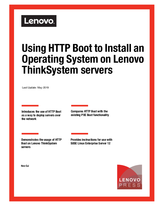Author
Updated
14 May 2019Form Number
LP0736PDF size
24 pages, 861 KBAbstract
HTTP Boot is client-server communication based application. It combines the Dynamic Host Configuration Protocol (DHCP), Domain Name System (DNS), and Hypertext Transfer Protocol (HTTP) to provide the capability for system deployment and configuration over the network. This new capability can be utilized as a higher-performance replacement for Trivial File Transfer Protocol (TFTP) based Preboot Execution Environment (PXE) Boot methods of network deployment.
This document provides a brief introduction to the HTTP Boot mechanism, instructions on setting up the HTTP Boot server on SUSE Linux Enterprise Server 12 SP2, and a practice of installing SLES 12 SP2 on a Lenovo® ThinkSystem™ server using HTTP Boot. HTTP Boot is also supported on SLES 12 SP3, SLES 12 SP4 and SLES 15.
This paper is intended for IT administrators. Readers are expected to have the basic knowledge of network deployment.
Table of Contents
Introduction
HTTP Boot architecture
Using HTTP Boot with ThinkSystem servers
Acronyms
Author
Change History
Changes in the May 14 update:
- Added a note regarding SLES support of HTTP Boot with SLES 12.x and SLES 15 and the dropping of HTTP Boot support with SLES 12.2 with UEFI firmware released November 2019. See “Using HTTP Boot with ThinkSystem servers” on page 7.
Configure and Buy
Full Change History
Course Detail
Employees Only Content
The content in this document with a is only visible to employees who are logged in. Logon using your Lenovo ITcode and password via Lenovo single-signon (SSO).
The author of the document has determined that this content is classified as Lenovo Internal and should not be normally be made available to people who are not employees or contractors. This includes partners, customers, and competitors. The reasons may vary and you should reach out to the authors of the document for clarification, if needed. Be cautious about sharing this content with others as it may contain sensitive information.
Any visitor to the Lenovo Press web site who is not logged on will not be able to see this employee-only content. This content is excluded from search engine indexes and will not appear in any search results.
For all users, including logged-in employees, this employee-only content does not appear in the PDF version of this document.
This functionality is cookie based. The web site will normally remember your login state between browser sessions, however, if you clear cookies at the end of a session or work in an Incognito/Private browser window, then you will need to log in each time.
If you have any questions about this feature of the Lenovo Press web, please email David Watts at dwatts@lenovo.com.

